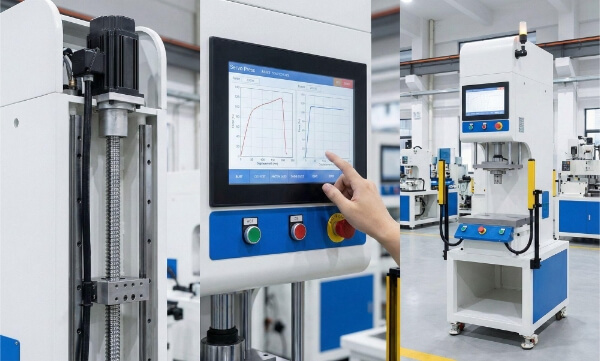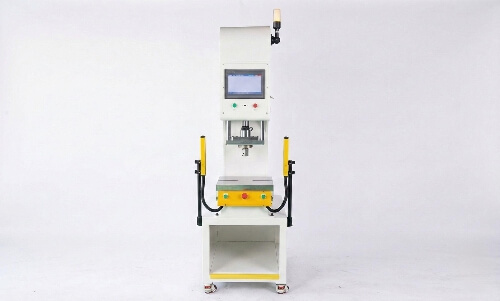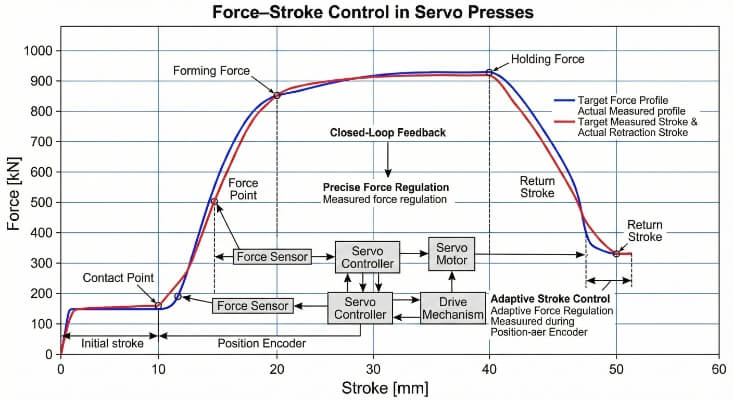Lo stampaggio dell'acciaio per molle offre forza, flessibilità e buona resistenza alla fatica, motivo per cui viene utilizzato in prodotti come le clip per auto e i dispositivi di fissaggio industriali. Tuttavia, non è sempre semplice da lavorare. Per ottenere una qualità costante, è necessario comprendere ogni fase del processo e sapere come risolvere i problemi senza sprecare tempo o materiale.
Il settore dello stampaggio di acciaio per molle cambia rapidamente. Questa guida illustra i processi principali, le sfide più comuni e le nuove idee che influenzano i moderni componenti per molle. La lettura di questa guida vi permetterà di capire meglio come tutto si combina.
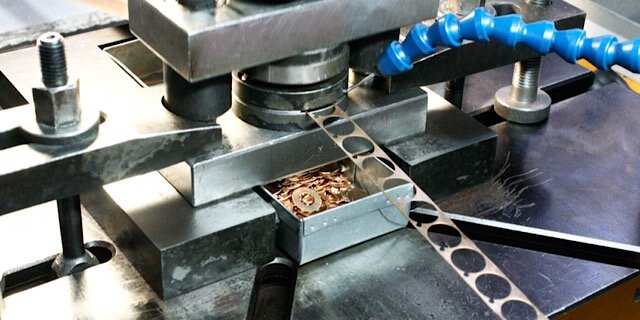
Che cos'è lo stampaggio di acciaio per molle?
Lo stampaggio di acciaio per molle è un processo che utilizza una pressa e uno stampo abbinato per tagliare e modellare sottili fogli o strisce di acciaio per molle. Lo stampo applica una pressione e un movimento controllati per formare il materiale. Questo processo può eseguire diverse operazioni, tra cui tranciatura, perforazione, piegatura, coniatura, goffratura e imbutitura. Per ottenere velocità e qualità costante, i produttori spesso alimentano il materiale da bobine.
Gli ingegneri scelgono i tipi di acciaio per molle in base ai requisiti di resistenza e di ritorno elastico. Le scelte più comuni includono acciai ad alto tenore di carbonio come il 1075 o il 1095 e acciai per molle inossidabili come il 301. Alcuni pezzi richiedono il trattamento termico e il rinvenimento dopo la formatura, mentre altri utilizzano materiale pre-temperato per ridurre le fasi di produzione.
Il processo di base segue una sequenza precisa. Scegliere la qualità e lo spessore giusti. Tagliare il contorno del pezzo. Formare e coniare le caratteristiche necessarie. Rimuovere le bave e ridurre le tensioni. Applicare una finitura, come la passivazione o la placcatura. Infine, ispezionare i pezzi per verificarne la conformità alle specifiche.
Proprietà e tipi di acciaio per molle
Gli acciai per molle devono piegarsi senza rompersi e tornare sempre in forma. Di seguito, analizzeremo le caratteristiche che lo rendono possibile e metteremo in evidenza i gradi più utilizzati per lo stampaggio.
Caratteristiche principali dell'acciaio per molle
- L'acciaio per molle ha un'elevata resistenza allo snervamento, per cui ritorna alla sua forma originale dopo il carico.
- Offre una lunga durata a fatica, consentendo ai pezzi di resistere a molti cicli senza incrinarsi.
- Il materiale presenta un ritorno elastico dopo la formatura, quindi gli utensili devono consentire un ritorno elastico.
- Trattamento termico aumenta la resistenza e fissa la tempra. I nastri pre-temperati possono saltare questa fase.
- La formabilità varia in base al contenuto di carbonio e alla tempra. Le tempere più morbide si piegano più facilmente con un minor rischio di cricche.
Gradi e leghe comuni utilizzati nello stampaggio
- SAE 1074 / 1075 (ad alto tenore di carbonio): Buona combinazione di resistenza e formabilità. Comune nelle clip, nei morsetti e nelle molle piatte.
- SAE 1095 (ad alto tenore di carbonio): Resistenza e durezza molto elevate, con un eccellente ritorno di fiamma. Può incrinarsi se i raggi di curvatura sono troppo stretti.
- SAE 1050-1065 (ad alto tenore di carbonio): Gamma di carbonio moderata per una formatura più semplice rispetto al 1095, pur mantenendo buone qualità elastiche.
- 301 Inossidabile (da 1/4 di duro a completamente duro): Resistente alla corrosione e indurisce durante la formatura. Adatto per clip, contatti e chiusure.
- 17-7PH Inox: Tipo a indurimento per precipitazione con elevata resistenza dopo l'invecchiamento. Mantiene la resistenza a temperature più elevate; è comune nei componenti aerospaziali e di precisione.
- 410 / 420 Inossidabile (martensitico): Temprabile e magnetico, con una migliore resistenza all'usura rispetto al 301. Resistenza alla corrosione inferiore rispetto ai gradi austenitici.
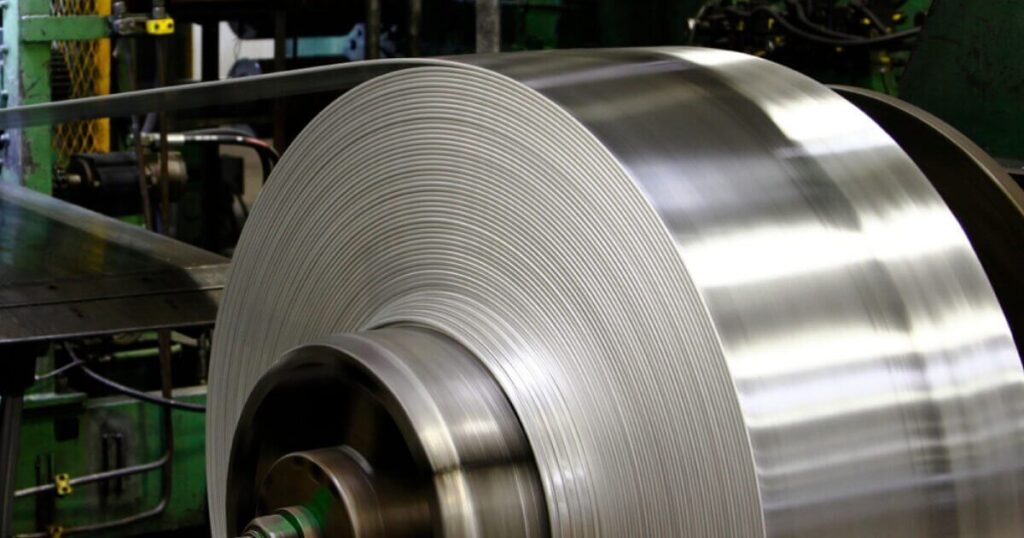
Il processo di stampaggio dell'acciaio per molle
Lo stampaggio dell'acciaio per molle segue un percorso ben preciso, dal coil grezzo al pezzo finito. Qui di seguito illustriamo le modalità di preparazione del materiale, le fasi di base del processo e i principali tipi di stampaggio utilizzati per i componenti a molla.
Preparazione della materia prima per lo stampaggio
Il processo inizia con la scelta della qualità e dello spessore dell'acciaio per molle. Il materiale viene solitamente fornito in rotoli o strisce piatte. Deve soddisfare le specifiche di durezza, tolleranza di spessore e condizioni superficiali.
Successivamente, la bobina viene srotolata e appiattita, se necessario. In questo modo si rimuove qualsiasi curva o curvatura che potrebbe influire sulla precisione. Alcune officine puliscono o lubrificano il nastro per ridurre l'usura degli utensili e migliorare la finitura dei pezzi.
Flusso di lavoro dello stampaggio passo dopo passo
- Alimentazione del materiale: La bobina entra nella pressa grazie a un raddrizzatore e a un alimentatore. Questo assicura un movimento e una posizione costanti.
- Oscuramento o perforazione: La pressa taglia forme di pezzi o fori con una forza elevata. In questo caso sono importanti bordi puliti e privi di bave.
- Formare: Il metallo si piega o si modella utilizzando punzoni e stampi abbinati. Il ritorno elastico deve essere tenuto in considerazione nella progettazione dello stampo.
- Formazione secondaria: Nella stessa corsa della pressa o in una seconda stazione possono seguire curve o coniature supplementari.
- Sbavatura e pulizia: Vengono eliminati gli spigoli vivi. I pezzi vengono spesso puliti per l'ispezione o la finitura.
- Trattamento termico: Se il pezzo è stato formato morbido, viene temprato e rinvigorito per impostare le sue proprietà elastiche.
Tipi di tecniche di timbratura
- Stampaggio progressivo: La più comune per i componenti a molla. Un nastro si muove attraverso uno stampo con molte stazioni. Ogni stazione aggiunge un passaggio: taglio, piegatura, formatura, fino alla caduta del pezzo finale.
- Stampaggio di stampi composti: Esegue più operazioni in un'unica stazione. Utile per i pezzi piatti con caratteristiche su un piano.
- Stampaggio a trasferimento: Sposta il pezzo da una stazione all'altra con le dita meccaniche. Consente di realizzare forme complesse e di eseguire trafile profonde.
- Cancellazione fine: Produce bordi molto lisci e precisi. Ideale per pezzi con tolleranze strette o superfici visibili.
Sfide comuni nello stampaggio dell'acciaio per molle
L'acciaio per molle è forte e flessibile, ma lo stampaggio comporta problemi unici. Di seguito analizziamo due aree problematiche principali: la durata degli utensili e i difetti dei pezzi durante la formatura.
Usura e manutenzione degli utensili
L'acciaio per molle è più complesso della maggior parte dei materiali in fogli. Ciò significa che l'usura di punzoni e matrici è maggiore e gli spigoli taglienti si opacizzano più rapidamente. Rivestimenti come il TiN o inserti in carburo possono aiutare, ma gli utensili necessitano comunque di controlli frequenti.
Se gli utensili si usurano in modo non uniforme, i pezzi vanno fuori specifica. I tagli diventano grossolani e le curve perdono precisione. La forza della pressa aumenta. Questo affatica la pressa e ne riduce la durata. Le officine devono programmare spesso la manutenzione degli utensili e monitorarne la durata in base al numero di pezzi.
Anche la lubrificazione influisce sull'usura. Senza una quantità sufficiente di lubrificante, l'attrito si accumula rapidamente, causando la formazione di gocce o la lacerazione dei bordi. Una quantità eccessiva di lubrificante, invece, provoca macchie o problemi di pulizia. È importante trovare il giusto equilibrio.
Screpolature, rughe e difetti
Le crepe si formano quando il metallo non può allungarsi o piegarsi a sufficienza. Ciò accade in corrispondenza di angoli acuti, raggi stretti o dove il pezzo si assottiglia troppo. Per risolvere questo problema, gli ingegneri possono ammorbidire l'acciaio prima della formatura o aumentare i raggi di curvatura.
Il raggrinzimento si verifica quando la compressione costringe il metallo a piegarsi. Si verifica in caso di imbutiture profonde o flange larghe. Un supporto nello stampo o una migliore pressione del supporto del pezzo grezzo aiutano a prevenirlo.
Altri difetti includono bave sui bordi, segni superficiali o tagli incompleti. Questi difetti sono spesso dovuti a utensili opachi, a un'errata distanza tra gli stampi o a una forza di pressatura non uniforme.
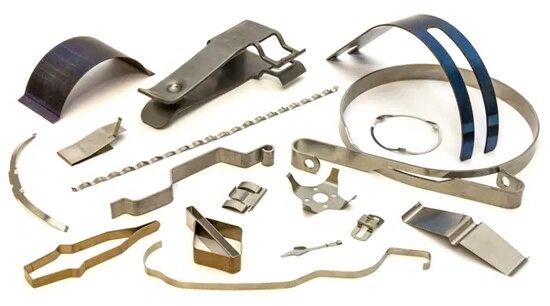
Applicazioni tipiche in tutti i settori
I componenti stampati in acciaio per molle supportano molte funzioni critiche. La loro forza, flessibilità e resistenza alla fatica sono funzionali in ambienti ad alto carico e ad alto numero di cicli. Ecco come vengono utilizzati da diversi settori industriali.
Automotive
Le case automobilistiche utilizzano parti in acciaio per molle stampate per clip, spessori, parentesie anelli di fissaggio. Questi componenti tengono i pannelli, fanno passare i cablaggi o fissano i pezzi dell'assetto. I sistemi di sospensione utilizzano distanziali e rondelle in acciaio per gestire i carichi.
Le parti stampate delle molle sono utilizzate anche nei telai dei sedili, nei piantoni dello sterzo e nei meccanismi delle porte. La loro resistenza alle vibrazioni e alle sollecitazioni ripetute è fondamentale. La capacità di produrre in serie questi componenti con tolleranze ristrette consente di contenere i costi.
Medico
I dispositivi medici hanno bisogno di componenti piccoli, puliti e precisi. L'acciaio per molle è utilizzato nelle clip chirurgiche, negli strumenti dentali e nelle guide per aghi. I componenti devono flettersi senza rompersi e tornare sempre in forma.
Gradi come il 17-7 PH e l'inossidabile 301 sono comuni qui. Offrono resistenza alla corrosione e possono essere sterilizzati. Un controllo rigoroso della finitura superficiale e della qualità dei bordi è fondamentale per la sicurezza.
Aerospaziale
Il settore aerospaziale richiede componenti leggeri e ad alta resistenza in grado di sopportare forze estreme. L'acciaio per molle è utilizzato in leveraggi di controllo, elementi di fissaggio, morsetti e sistemi di smorzamento delle vibrazioni.
La capacità di assorbire le sollecitazioni senza subire deformazioni permanenti è utile nei sistemi di controllo di volo e nei carrelli di atterraggio. I componenti devono soddisfare standard rigorosi per quanto riguarda la durata a fatica e le prestazioni a diverse temperature.
Strumenti industriali
In ambito industriale, i componenti stampati in acciaio per molle sono utilizzati in utensili manuali, utensili elettrici e macchinari. Ne sono un esempio gli anelli elastici, i portalama, i fermi e le chiusure di sicurezza.
Questi componenti sono in grado di sopportare urti ripetuti e di mantenere la loro forma. La resistenza dell'acciaio per molle mantiene bassa l'usura e costanti le prestazioni, anche in condizioni difficili in officina o sul campo.
Soluzioni e migliori pratiche
La timbratura dell'acciaio per molle può avvenire senza problemi con l'impostazione e le abitudini corrette. Queste sezioni forniscono semplici metodi per ridurre i difetti, prolungare la durata degli utensili e migliorare la qualità della produzione.
Regolazioni del processo per ridurre i difetti
Utilizzare la distanza corretta tra gli stampi. L'acciaio per molle ha bisogno di più spazio tra il punzone e la matrice rispetto ai metalli più morbidi. In questo modo si mantengono puliti i tagli e si riducono le rotture dei bordi.
Applicare una curvatura eccessiva negli utensili per compensare il ritorno elastico. Provare diverse angolazioni durante la prototipazione per trovare il risultato migliore. Non affidatevi a impostazioni univoche.
Rallentare leggermente la pressa se compaiono crepe o grinze. Un po' di tempo in più durante la formatura aiuta il metallo a scorrere senza danni.
Regolare raggio di curvatura. Se si formano crepe in corrispondenza delle curve, aumentare il raggio interno. Il raggio di curvatura sicuro per l'acciaio per molle è solitamente pari a 1,5-2 volte lo spessore.
Suggerimenti per la lubrificazione e la movimentazione dei materiali
Scegliere un lubrificante per acciaio ad alta resistenza. Cercate quelli con additivi per pressioni estreme. Questi riducono l'attrito, il calore e l'attrito.
Applicare una quantità di lubrificante appena sufficiente. Una quantità eccessiva di lubrificante può causare lo slittamento dell'alimentatore, mentre una quantità insufficiente provoca l'usura dell'utensile e l'incisione della superficie. I sistemi a spruzzo o i rulli offrono un controllo migliore rispetto all'applicazione manuale.
Mantenere le bobine pulite e asciutte. Sporco o ruggine causano un'alimentazione non uniforme e possono danneggiare gli strumenti. Conservare il materiale in un luogo asciutto, lontano dal pavimento e dall'umidità.
Utilizzare raddrizzatori e alimentatori adeguati. L'acciaio per molle ha una forte memoria e può rimanere curvo. Un buon sistema di livellamento lo mantiene piatto per una timbratura uniforme.
Conclusione
Lo stampaggio di acciaio per molle è una scelta saggia per i pezzi che devono flettersi, mantenere la forma e durare nel tempo. Supporta una produzione rapida, una qualità costante e vari design. Questo processo svolge un ruolo chiave in tutti i settori industriali, dalle staffe nelle automobili alle clip negli strumenti medici. Con il materiale, l'attrezzatura e la configurazione giusti, offre risultati forti e ripetibili su scala.
Avete bisogno di aiuto per i pezzi stampati in acciaio per molle personalizzati? Lavoriamo con diversi gradi, tipi di pezzi e volumi. Sia che stiate costruendo prototipi o scalando la produzione, discutiamo di come possiamo supportare il vostro prossimo progetto.
Ciao, sono Kevin Lee

Negli ultimi 10 anni mi sono immerso in varie forme di lavorazione della lamiera, condividendo qui le mie esperienze in diverse officine.
Contattate

Kevin Lee
Ho oltre dieci anni di esperienza professionale nella fabbricazione di lamiere, con specializzazione nel taglio laser, nella piegatura, nella saldatura e nelle tecniche di trattamento delle superfici. In qualità di direttore tecnico di Shengen, mi impegno a risolvere sfide produttive complesse e a promuovere innovazione e qualità in ogni progetto.

